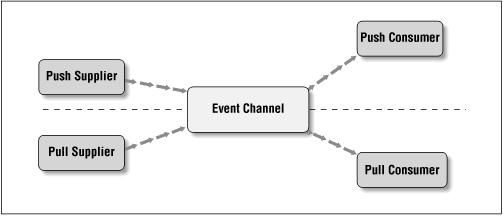Event Service
The Event Service provides asynchronous communications between cooperating, remote objects. It’s most similar in nature to the message-passing and event-based messaging we saw in Chapter 6.
The CORBA Event Service is based on a model involving suppliers and consumers of events, connected by event channels that carry events back and forth between the two. An event channel can support multiple event suppliers and multiple event consumers. The Event Service also supports two event propagation styles for both consumers and suppliers of events: push style and pull style. A push-style consumer has events pushed to it by its event suppliers, while a pull-style consumer explicitly pulls events from its suppliers. On the other end of the event channel, a push-style supplier pushes events to its consumers, while a pull-style supplier waits for its consumers to pull events from it. Figure 2.2 shows the relationship between event suppliers, consumers, and channels. In the figure, arrows indicate flow of events, and the location of the head of the arrow indicates which entity drives the event transfer.
 |
Although the event channel provides a physical connection between consumers and suppliers in the Event Service model, logically each consumer attaches itself to one or more suppliers, and each supplier attaches itself to one or more ...
Get Java Distributed Computing now with the O’Reilly learning platform.
O’Reilly members experience books, live events, courses curated by job role, and more from O’Reilly and nearly 200 top publishers.

